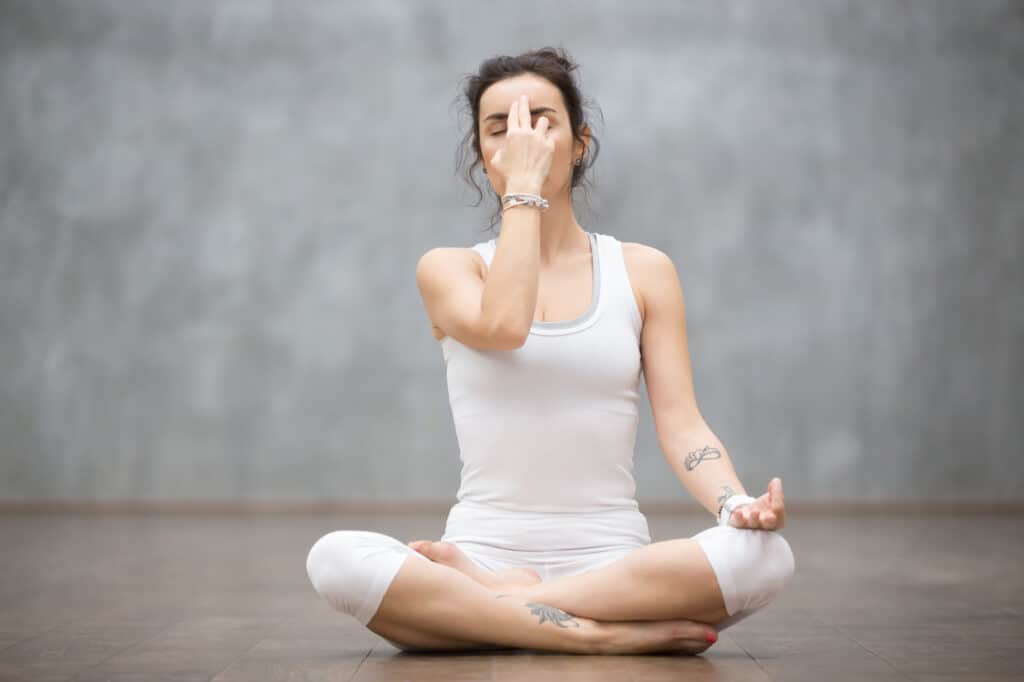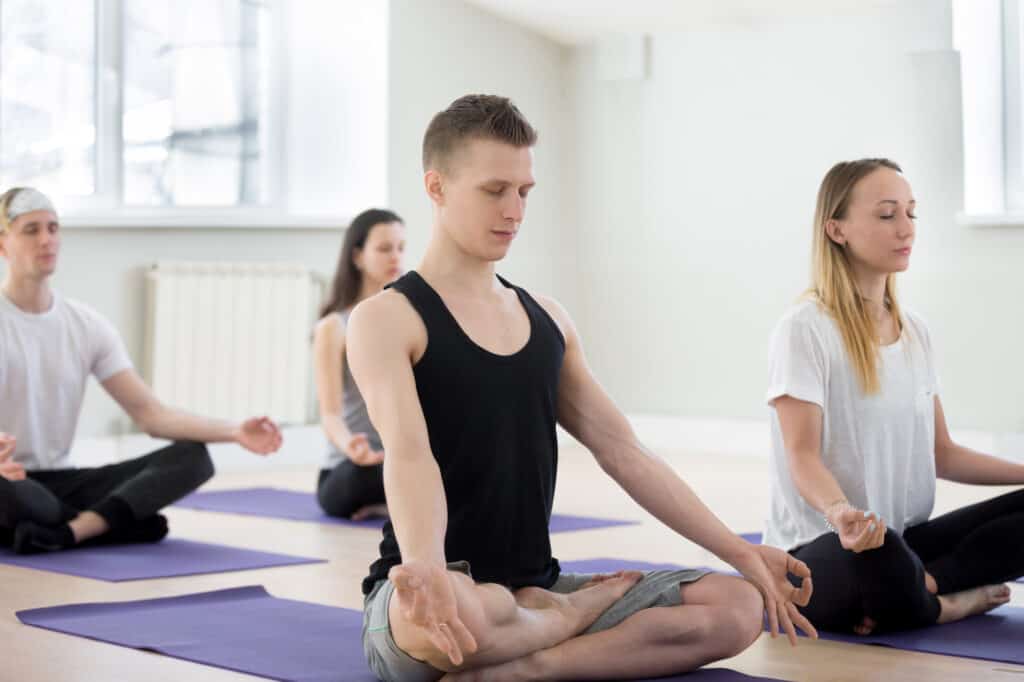Breathing is something we do every day without even thinking of it. What if we tell you that changing the way you breathe can help you become more energized but calm and focused?
Besides all the physiological benefits it has, being aware of your breath calms down thoughts and emotions. It helps you move through the complicated asana or stretches more harmonically, as well as you can literally “breath out” the tension of a tough day at work. The skill to peace your mind will also be helpful when you are off the yoga mat.
The conscious control over the vital process of breathing is the foundation of the yoga practice. So let’s have a closer look at all the how’s and why’s of yoga breathing.
What Is the Relationship between Movement and Breath in Yoga?
At the physical level, yoga breathing helps activate lungs, abdomen muscles, and the diaphragm that may be tight and stiff if your usual breathing pattern does not include all those organs in work. On the energy level, yogis speak about “prana,” or life energy that rides on your breath. And depending on how do you act with your breath – you feel full of energy or exhausted.
When you inhale and bring your arms up, or lengthen your spine, or extend your chest – you increase the volume of your lungs and activate the abdominal muscles for deeper inhalation. Twists, folds, and press-ups are done on the exhale.
You can practice for hours, but if you skip deep breathing – you hardly can benefit from the practice. Deep conscious breathing leads the energy flow smoothly and helps your muscles relax.
What Are the Benefits of Pranayama for Breathing?

There are many outcomes you get when you master yogic breathing. Here is only a small list of some of those:
- Slow yoga breathing lowers stress thanks to the activation of a parasympathetic nervous system via the vagus nerve;
- With a deeper breath, the volume of your lungs increases, and working muscles are supplied with more oxygen, thanks to Bohr’s effect. Thus, the blood circulation improves, and the vital body system function more efficiently;
- Better concentration and presence help you to be aware of your thoughts and intentions. You can stay here and now and be truly present as an observer of your emotional and mental state with no judgments;
- Lower risk of injury. Breathing deeply, you inform your body you are in a safe place, thus decreasing the muscle tension and fear hormones input in your blood.
How Does Pranayama Affect the Brain?
Apart from creating a conscious connection of body and mind, yoga breathing or pranayama affects your brain at the cell’s level.
Recent research was held to understand how exactly the brain works if you use different yoga breathing exercises. They conclude that somatic effect from the movement of one’s abdominal muscles during yoga breathing excites specific body receptors connected to pre-Rolandic and cortical areas in the brain. That changes the brain’s activity and frequencies of electromagnetic waves the brain creates. Each pranayama influences the brain in a different way activating various zones.
Can Deep Breathing Heal?
The answer is yes. When you shift your breathing from shallow to more profound one that will hit all the central systems of your body: skin, digestive, immune, nervous, and cardiovascular, just to name a few.
Oxygen is an activator and participant of the body’s oxidation processes know as metabolism. So it’s a key to the body’s ability to reduce pain, lower stress, and regulate hormone production and renewal of cells.
Does Pranayama Reduce Belly Fat?
Doing the yoga breathing correctly and systematically, you can discover your belly loses fat. There is no direct connection between these two processes, but improved digestion helps your waist get thinner.
How to Lose Belly Fat in 2 Weeks
When you use yoga breathing in your practice – the activation of the diaphragm and abdominal muscles massages the digestive system and helps to recover its performance. Improved blood circulation helps your body to remove the toxins faster. This leads to changes in the body’s metabolism and the digestion of food. Yoga exercises and breathing paired with a healthy diet and sleep regime will increase the chances for weight loss.
Yogic Breathing: Where to Start?

Yoga breathing is not something you can start doing in your first yoga class. Even if you are fit and know yourself as a healthy person, the full range of yoga breathing techniques can be practiced only after having mastered the classic range of asanas.
But a road starts with the first step. If you are a beginner – start with simple exercises for deepening your breath, and then, when your body is ready, move on to more complex ones.
What Is the Yoga Breathing For Beginners?
The first thing you need to learn is to be aware of the way you actually breathe and breathe through your nose. Is it shallow? How deep is your inhale? Does your chest extend to the sides? How long can you stay calm and just observe the breath?
Breathing through your nose is a bit different from a fitness class if you used it attend one, so it’ll take some time to get used to it.
What Is Full Yogic Breath?
Also known as belly breathe or 3-part breathe. It engages the belly, rib cage, and upper parts of your chest. This exercise will be the best to expand your lungs and release the tightness in your chest.
How to do it:
You can do belly breathing from a seated or lay-down position.
- Relax your belly and put your hands on it. Inhale and extend the abdomen as if you have a balloon inside that is being filled with air. Exhale. Repeat 3-5 breathing cycles.
- Same position, but move your hands on the ribs (middle fingers touch each other). Inhale extending belly and sending the airflow up to your rib cage. Watch how the rib cage opens (your middle fingers start to move away from each other). Exhale and repeat for several rounds.
- Put your hands on your collarbones. As you inhale, try to send the air from your belly through ribs up to the collarbones to make them move too.
Advanced Yoga Breathing Techniques
The below pranayamas are more complex ones and will be useful for experienced yogis.
If you are a beginner, ensure you do them under the supervision of an experienced tutor. Be careful exercising the below two techniques if you have respiratory issues (asthma, bronchitis, etc.), high blood pressure (as this pranayama will increase it even more), disc issues. Consult a doctor before doing these breathing activities.
Ujjayi or Victorious Breathing
Avoid practicing Ujjayi if you have throat diseases or recent surgery, cardiovascular disease.
Kapalabhati or Fire Breathing
Don’t do Kapalabhati if you are pregnant, or have a recent abdominal surgery.
FAQs
What Is the Best Time to Do Pranayama?
Early morning is the best time for your pranayama practice. Make sure your stomach is empty. It’s not a good idea to exercise if you’ve just eaten a hearty breakfast.
What Are Mudras in Yoga: Ultimate Guide
It’s better to stay in a well-ventilated room or outdoors. Avoid windy and cold weather or air-conditioned rooms – your body should be comfortable with the environment.
What Is the Best Exercise for Lungs?
Full yogic breath is one of the best exercises to start working with your lungs. Ujjayi pranayama is the next step to train your respiratory organs and chest muscles.
How Long Should You Do Deep Breathing Exercises?
Experienced yogis: use 2 hours before the sunrise when your mind is yet free of thoughts and calm. Do it as an independent practice or at the beginning of your asana sequence.
Beginners: include breathing exercises in your training starting from 3-5 minutes at the beginning of your yoga practice and in 3-5 minutes in the end before the meditation or Savasana.